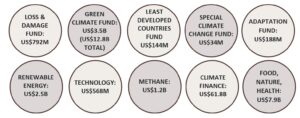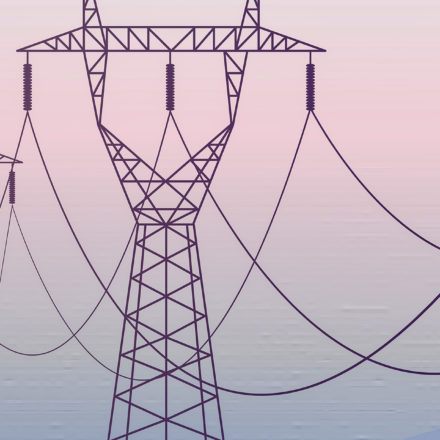From US$85b+ of public and private financial commitments, to commercialising hydrogen and heavy-emitting industries working together to transition: the 28th meeting of the United Nations Climate Change Conference (COP28), hosted by the United Arab Emirates, set a path to reach net zero faster.
Collaboration – to ‘unite, act, deliver’ – was key. We explored the need for cooperation across governments, business and researchers in our 2023 report on Navigating the Net Zero Transition (Southeast Asia, Japan and the Republic of Korea) and our 2022 report on The Climate Challenge.
Below, we share key COP28 outcomes, with a focus on the clean energy transition. This is a snapshot only. Many other COP28 initiatives are expected to have a significant impact, including:
- a pledge by 51 fossil fuel companies – representing 40 percent of global oil production – to cut methane leaks and other emissions from operations under the Oil and Gas Decarbonisation Charter
- commitments to reduce cooling-related emissions by at least 68% by 2050 compared to 2022 levels, along with a suite of other targets including establishing minimum energy performance standards, signed by more than 60 countries
- efforts to improve the understanding of the vital and positive role that equality and empowerment plays, through the Gender-Responsive Just Transitions & Climate Action Partnership endorsed by 68 countries
- better climate adaptation efforts and increased funding to communities facing threats, under the Declaration on Climate, Relief, Recovery and Peace signed by 74 countries and 43 organisations.
We are watching developments in 2024 and beyond. Visit KWM’s Take on COP28 and reach out to your local contact for help.

COP28 financial commitments – a snapshot…

COP28 key outcomes include…
Global Decarbonisation Accelerator – moving to clean energy, faster
Aims to expedite the transition to clean energy, including via multilateral efforts.
What was agreed? Cut emissions in energy generation and use by addressing supply and demand, with three core elements:
-
- Rapidly scale the energy system of tomorrow (including the Global Renewables and Energy Efficiency Pledge, and the Hydrogen Declaration of Intent – more on both below)
- Decarbonise the energy system of today (including the Oil and Gas Decarbonisation Charter and the Industrial Transition Accelerator – more below)
- Reduce methane and other non-CO2 greenhouse gases (including the Global Cooling Pledge and investments in methane abatement projects)
What are the implications? Set to increase the number of major scaling efforts under way across Asia and further mobilise funds behind opportunities.
-
-
- This plays into Australia’s clean energy export potential given its world-leading renewable resources and Singapore’s ambitions to become a green hydrogen hub.
- In Australia, there is already significant work underway to redesign retail and wholesale energy markets. For more detail for changes as they happen, see our regular market updates.
- Regional and global collaboration are essential to unlocking private investment.
-
Global Renewables and Energy Efficiency – international focus on 2030 goals
Encourages cross-border collaboration combined with local policies to encourage investment and electrification. In Asia, key players include Australia, Japan and the Republic of Korea.
What was agreed? Signed by 123 states, the pledge aims to triple the world’s renewable energy capacity (adding 11,000 GW) and double the annual rate of energy efficiency improvements by 2030. This includes sharing technology advancements and connecting grids across borders.
What are the implications? Strengthened international collaboration on renewable value chains and technology development. This includes facilitating the voluntary transfer of new technologies, expanding financial support for scaling renewables, reducing the cost of capital for renewable energy in emerging markets and accelerating cross-border grid connections.
-
-
- An increase in domestic policies intended to scale renewables. This includes accelerating permissions of renewable projects, expanding grid interconnections, encouraging increased private investment and promoting electrification.
- US and EU spearheaded the pledge. Australia, Canada, the UK, Japan, Korea and the United Arab Emirates are among other key signatories. However major players in the global energy market like China and India are absent. While China is responsible for a large proportion of the global increase in renewable energy capacity, countries like India would need to more than triple their renewables to meet the target.
-
Industrial Transition Accelerator – catalysing change in steel, concrete, transport and other industries
Brings together companies and associations across heavy-emitting industries to incentivise private investment in transition efforts.
What was agreed? The accelerator aims to increase demand for sustainable projects, support the development of new financial instruments and work with governments to calibrate policy settings to maximise private investment.
-
-
- US$30m in seed capital (from Bloomberg Philanthropies and the COP28 presidency) will primarily target efforts to commercialise and deploy technologies such as green hydrogen, energy storage and CCS.
-
What are the implications? Innovation and collaboration is expected across heavy-emitting industries including steel, aluminium, concrete and air transport.
-
-
- The 35 companies and six industry associations that endorsed the accelerator include the World Steel Association, International Aluminium Institute, Global Renewable Alliance, Global Cement and Concrete Association, Oil and Gas Climate Initiative, International Air Transport Association.
- Initiatives across Asia are reducing reliance on diesel, improving carbon capture and sequestration (CCS) and developing green steel technology. But more is needed to facilitate decarbonisation across heavy-emitting sectors – and the accelerator is intended to guide and quicken the shift.
- As with all initiatives to fund decarbonisation, a sustainable finance taxonomy is essential to ensure participating private investors have a common understanding of where and how to deploy capital.
-
Mutual Recognition of Certification Schemes for Renewable and Low-Carbon Hydrogen and Hydrogen Derivatives – sailing to sustainable fuels
Acknowledges the essential role of renewable and low-carbon hydrogen (and its derivatives) and the need to cooperate. Low-carbon hydrogen is becoming a central aspect of the global energy transition as the world looks to sustainable fuels for shipping and aviation.
What was agreed? Participating countries (endorsed by 39) will work towards the mutual recognition of hydrogen certification schemes and accelerate the development of technical solutions.
What are the implications? Participating countries – including the US, Australia, India, the Republic of Korea, Saudi Arabia and the UAE – intend to nominate government experts to facilitate solutions..
-
-
- Globally recognised standards (such as cacluating GHG emissions) could increasingly apply to hydrogen production and transportation, based on an intention to consider steps to support mutual recognition.
-
Loss and Damage Fund – helping developing nations
Day one of COP28 marked the groundbreaking establishment of the Loss and Damage Fund agreed to at COP27.
What was agreed? The fund will financially assist developing nations suffering from climate change impacts.
What are the implications? Developing nations will receive vital support to decarbonise, as well as adapt to and mitigate the devastating effects of climate change. Developed nations have pledged more than US$720m combined.
Declaration on Climate and Health – connecting environmental and human wellbeing
Recognises the connection between environmental health and physical and mental wellbeing – particularly the effect of greenhouse gas emissions and air pollution on respiratory health.
What was agreed? Commitment to make health systems more climate-resilient and protect human health from the adverse effects of climate change.
-
-
- 121 signatories including the US, UK, Australia, EU, the Republic of Korea, Japan, Vietnam and the UAE.
-
What are the implications? Greater efforts to address the environmental determinants of health as part of mitigation and adaptation efforts.
-
-
- Increased efforts to combat internal and global inequality should also follow under the pledge, acknowledging the link between climate, health and other social inequalities. This includes the pursuit of UN Sustainable Development Goals and ensuring global access to sanitation and hygiene.
-
CHAMP for Climate Action – multilateralism as champion
The Coalition for High Ambition Multilevel Partnerships (CHAMP) is another attempt to renew global, regional and local co-operation on climate targets.
What was agreed? CHAMP focuses on the role of sub-national governments in the mitigation of climate change. The signatories pledged to:
-
-
- Consult and collaborate with subnational governments on the implementation of national and international climate strategies
- Create inclusive processes for local governments to contribute to country-level environmental targets
- Secure adequate financing for local government initiatives, including the development of new sovereign or quasi-sovereign financial instruments to secure public and private financing
-
What are the implications? While the pledge was signed by key global players such as the US, many more (including Australia) have not participated.
-
-
- The signatories have stated that the document is non-binding and does not give rise to any rights or obligations.
- It will fall to see whether any of these principles are implemented before COP29.
-
Sustainable Agriculture – food security and resilience
On 1 December, 134 countries (including Australia, China, the US and UK) signed the COP28 Declaration on Sustainable Agriculture, Resilient Food Systems and Climate Action.
What was agreed? The Signatories committed to five objectives:
-
-
- Scaling-up adaptation and resilience activities to reduce vulnerability of food producers (such as farmers or fisherfolk) to the impacts of climate change including through provision of financial and technical support to promote sustainable food production
- Promoting food security and nutrition by supporting vulnerable people (such as women, youth, people with disabilities, family farmers, smallholders, Indigenous Peoples through social protection systems, safety nets, school feeding and procurement programs)
- Supporting people working in agriculture and food systems whose livelihoods are threatened by climate change to maintain decent work
- Strengthening integrated management of water in agriculture and food systems at all levels to reduce their adverse impacts to nearby communities
- Maximising climate and environmental benefits by protecting and restoring natural ecosystems by shifting from higher greenhouse gas-emitting practices to more sustainable production and consumption approaches including by reducing food loss and wastage.
-
What are the implications? Greater focus on – and funding for – technology and innovation to help build climate resilience and ensure sustainable food production and secure water supplies.
-
-
- In Australia, the Federal Government highlighted that it is working with the agricultural sector to reduce emissions and ensure sustainable productivity.
-
The next COP will take place in Azerbaijan’s capital city, Baku, from November 11-24. For updates on the latest regulatory and other developments, subscribe to our ESG content.









